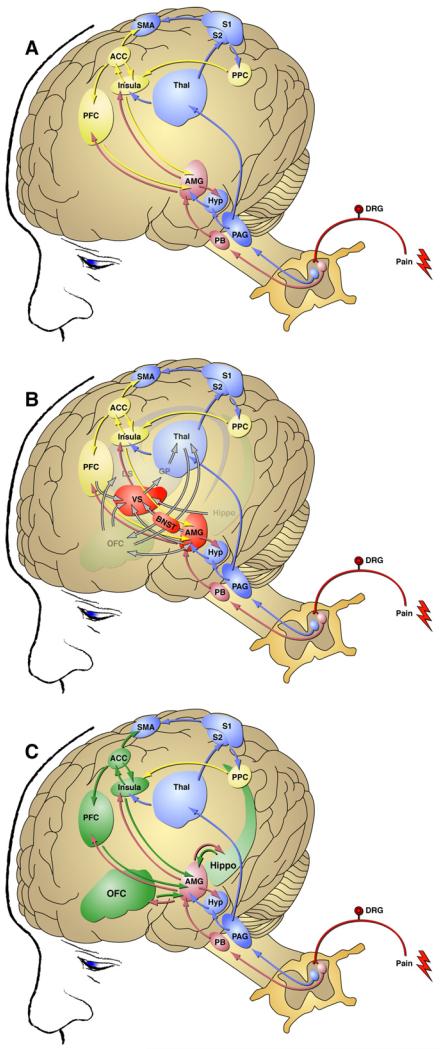Fig. 1.
Intersection of neural substrates mediating nociception and alcohol dependence. (A) Ascending pathways mediating the supraspinal processing of pain. Blue structures are involved in the “fast” processing of pain via the spinothalamic tract and arrive indirectly at the amygdala. Pink structures are involved in the “fast” processing of pain via the spinoparabrachial-amygdala pathway that arrives directly at the amygdala. Yellow structures are involved in the “slower” cognitive/affective processing of pain. (B) Pathways for the supraspinal processing of pain superimposed on key elements of addiction circuitry implicated in negative emotional states. Addiction circuitry is composed of structures involved in the three stages of the addiction cycle: binge/intoxication (ventral striatum, dorsal striatum, and thalamus), withdrawal/negative affect (ventral striatum, bed nucleus of the stria terminalis, central nucleus of the amygdala; red structures), preoccupation/anticipation (prefrontal cortex, orbitofrontal cortex, and hippocampus). Note the significant neuroanatomical intersection of the supraspinal regulation of pain and addiction in the amygdala. (C) Regions involved in the preoccupation/anticipation stage of addiction (green) are accessed by ascending pain circuitry, and this interaction may promote compulsive alcohol seeking under conditions of acute or chronic pain. ACC, anterior cingulate cortex; AMG, amygdala; BNST, bed nucleus of the stria terminalis; DRG, dorsal root ganglion; DS, dorsal striatum; GP, globus pallidus; Hippo, hippocampus; Hyp, hypothalamus; Insula, insular cortex; OFC, orbitofrontal cortex; PAG, periaqueductal grey; PB, parabrachial nucleus; PFC, prefrontal cortex; PPC, posterior parietal cortex; S1, S2, somatosensory cortex; SMA, supplementary motor area; Thal, thalamus; VS, ventral striatum. Modified with permission from Blackburn-Munro and Blackburn-Munro (2003),Koob et al. (2008), and Shurman et al. (2010).

